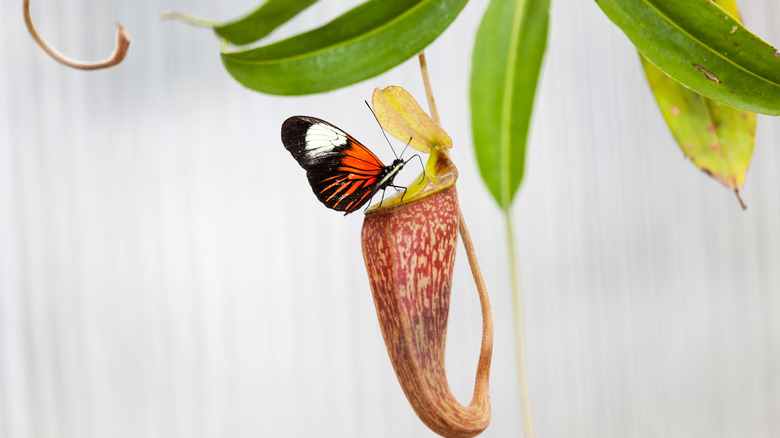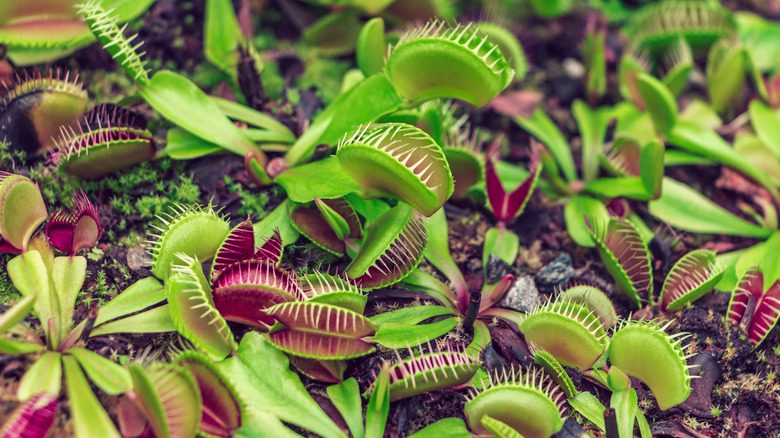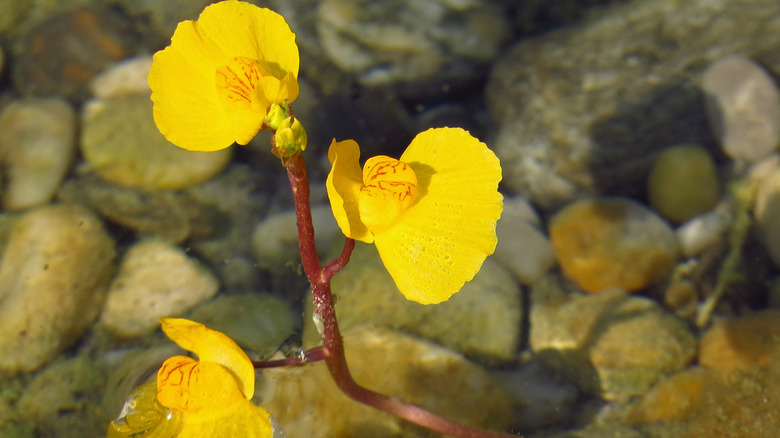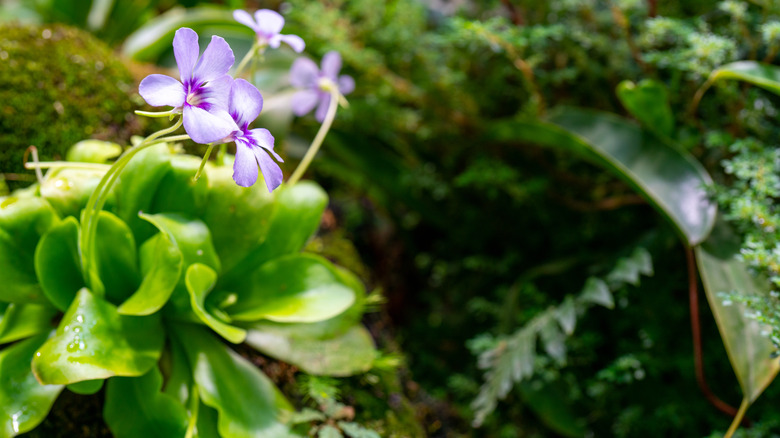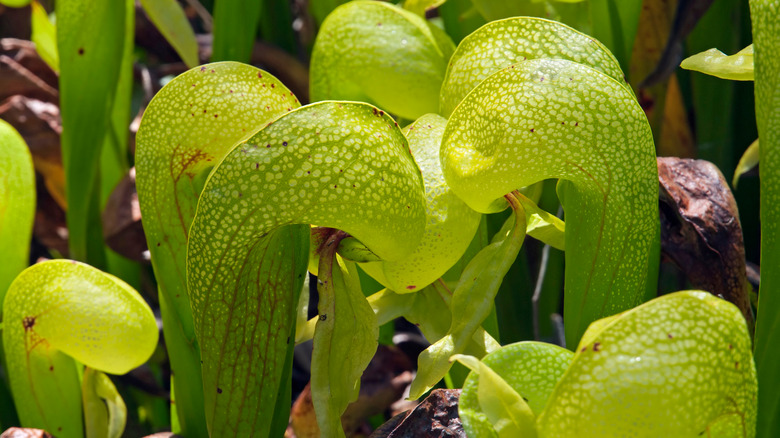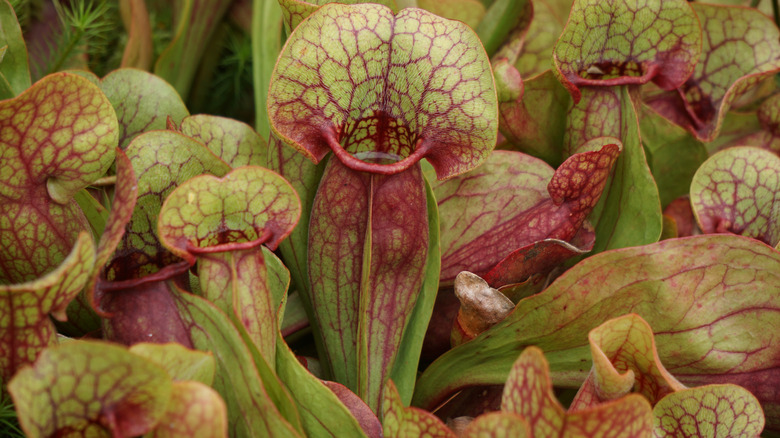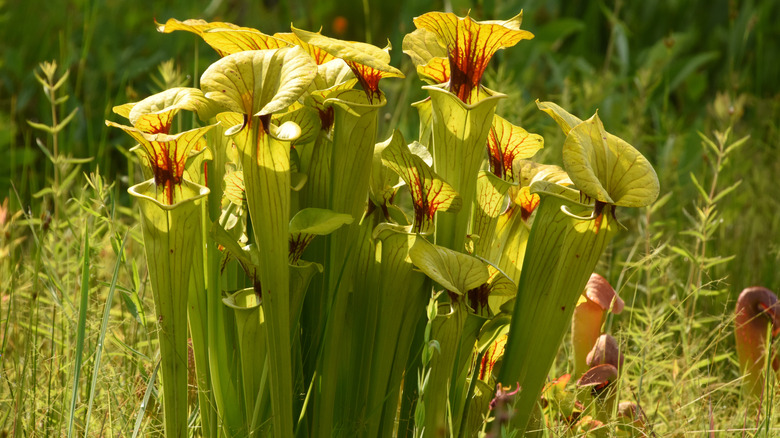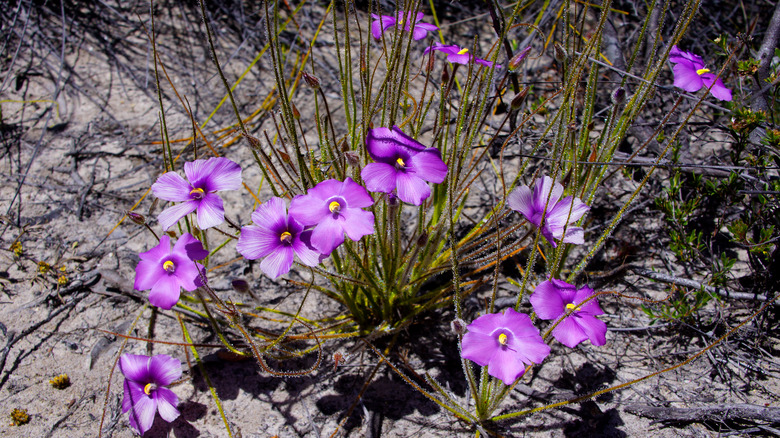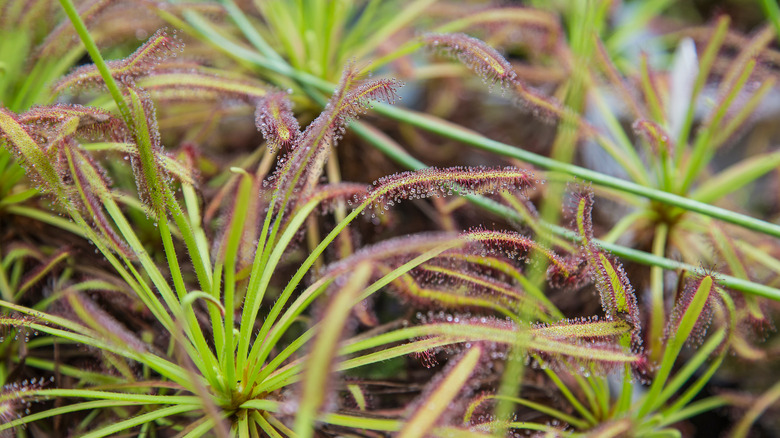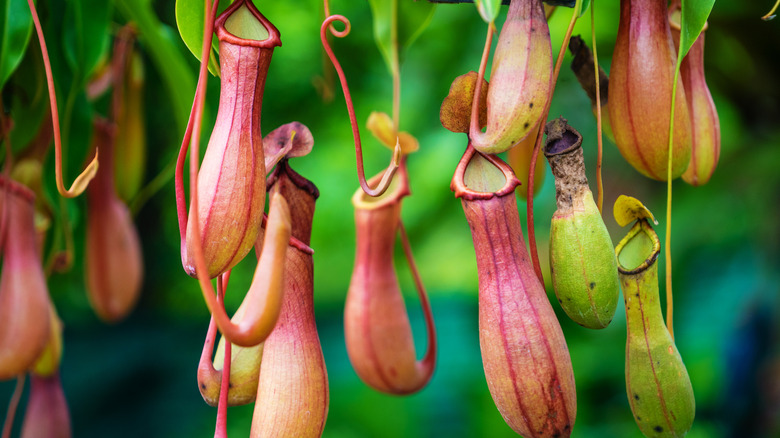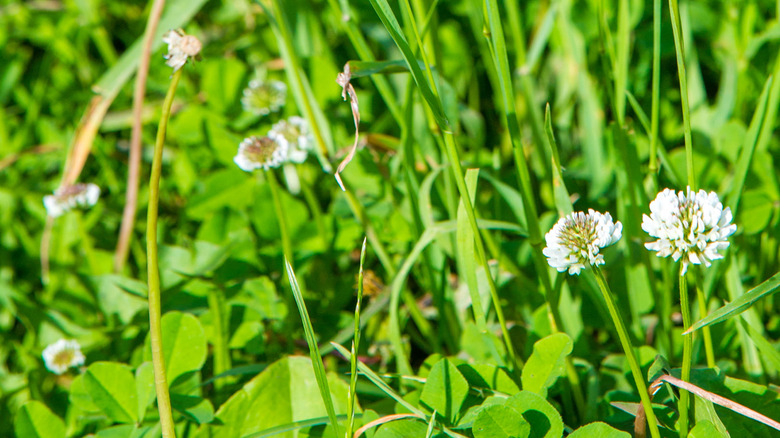10 Strange Plants That Actually Eat Bugs In Real Life
Plants eating animals seems like an idea straight out of science fiction, but it happens — and in more ways than one. According to the Natural History Museum, there are more than 600 types of carnivorous plants, and Live Science notes that their odd behavior dates as far back as 70 million years. It is all in the genes, as many plants had to resort to eating bugs as a means of survival due to a lack of sufficient nutrition in soil.
Some insect-eating plants feature weird and extraordinary snares, such as folding, barbed lobes and deep, narrow cups that trap unsuspecting victims, while others catch their prey with sweet, sticky nectar on their leaves and stems. While most carnivorous plants live in areas that have soggy water, some of these plants thrive in arid conditions. We've investigated and found ten strange plants that do not mind making a meal out of a curious critter.
1. Venus flytrap
Perhaps the most popular insect-eating plant is the venus flytrap (Dionaea muscipula). This plant has hinged, oval-shaped lobes that are quite good at catching insects. The lobes are lined with tiny hairs and small, barb-like protrusions line the outer edges. When an insect lands inside the lobes, they close — the process is called thigmonasty — trapping their prey. Venus flytraps are one of the few carnivorous plants that use any kind of motion to capture insects, according to the National Wildlife Federation. The plant is native to North and South Carolina, and it does well in acidic soil that often lacks nutrients. The Venus flytrap is known to capture a variety of bugs including ants, spiders, beetles, and of course, flying insects. As a perennial, they produce small white flowers.
Bloom Season: spring
USDA Growing Zone: 7 to 10
Growing Conditions: plenty of indirect sun
Soil Type: acidic soil
Size: about five inches tall
2. Bladderwort
Bladderwort plants (Utricularia spp.) look innocent enough with small yellow or purple flowers at the ends of their leafless stems. They like soggy, wet soil, so you will most likely find them near streams, lakes, ponds, and even ditches. If they are near a body of water, the stem will most likely be leaning over the top of the water's edge. Their trap is a pair of leaves shaped like a bladder, which lies under the water's edge. The leaves are covered in tiny hairs, and when small insects such as mosquito larvae come close to the hairs, it triggers a response that opens the bladder. Inside the bladder is a sweet, sticky nectar which is hard for prey to resist. Once the insect goes inside for a taste, it cannot escape, per Gardening Know How.
Bloom Season: summer
USDA Growing Zone: common in all 50 states
Growing Conditions: at least four hours of direct sunlight per day
Soil Type: wet soil
Size: various sizes, running from several inches tall to several feet long
3. Butterwort
Another harmless-looking carnivores plant is the butterwort (Pinguicula) with its tiny, bright purple flowers. They are similar to bladderwort plants in that they thrive in wet areas. You will see them growing near water sources, such as streams and rivers where nutrients are scarce. Because the soil is poor, they need to feed on insects to stay alive, like the bladderwort. According to Minnesota Wildflowers, the fierceness of this plant comes in long leaves at the bottom of the stems that lay flat on the ground. Each stem will have anywhere from three to six of these leaves, and while they might look like ordinary leaves, they secrete a sticky substance that acts like sandpaper when small insects drop by to check them out.
Bloom Season: spring and summer
USDA Growing Zone: 3 through 7
Growing Conditions: full sun in moderate temperatures, partial sun in hot conditions
Soil Type: moist
Size: two to six inches tall
4. Cobra lily
The cobra lily (Darlingtonia californica), or the California pitcher plant, looks a little more perilous than the bladderwort and butterwort plants with its unusual, pitcher-shaped leaves. These leaves are narrow and deep, making the perfect snare. Inside the cup sits a sweet nectar, and once a curious insect enters the cup to taste it, they find it difficult to get out. Oregon State Parks notes that the curly-topped leaves are covered with sheer holes, which create various shades of light and dark that disorient any bugs that try to escape. Most insects become fatigued and fall deeper into the leaf where a pool of enzymatic fluid awaits to slowly devour them. Just like many other carnivorous plants, cobra lilies are found mostly in damp areas.
Bloom Season: spring
USDA Growing Zone: native to northern California and southern Oregon
Growing Conditions: full sun or partial shade
Soil Type: moist
Size: 16 to 30 inches tall
5. Purple pitcher plant
The purple pitcher plant (Sarracenia purpurea), like the cobra lily, also looks threatening. Often called the monkey cup, this plant is smart when it comes to survival. The pitcher has three parts that work to trap prey: a funnel-shaped pitcher, a slippery rim, and a lid. These plants release a sweet fragrance that attracts bugs. Just like with the cobra lily, once the critters find themselves in the pitcher, it is too late. The insects are quickly dissolved in a liquid of acid, as noted by the Missouri Botanical Garden. Strangely enough, purple pitcher plants can even capture vertebrate animals. New Scientist reported that in 2019, a scientist caught sight of a salamander trapped inside a pitcher plant while studying them in Canada. Like other insect-eating plants, pitcher plants can be found in wet soil that lacks many nutrients.
Bloom Season: spring
USDA Growing Zone: 6 to 8
Growing Conditions: a few hours of sunlight daily
Soil Type: moist
Size: varies from several inches to several feet tall
6. Yellow pitcher plant
Like purple pitcher plants, yellow pitcher plants (Sarracenia flava) catch their prey in tiny, funnel-shaped cups attached to the top of their stems. Gardenia explains that the pitchers look like trumpets, which explains why you might hear them referred to as trumpet plants. What makes these plants different, however, is a small, frilly, yellow leaf perched at the top of the pitcher that acts much like a lid. The nectar of the yellow pitcher plant is not a sticky substance that traps bugs — it is deadly and paralyzes insects after they land on the colorful leaf. Once paralyzed, the insects don't stand much of a chance. They eventually fall into the pitcher, where the enzymes at the bottom break them down for nutrients. Like most insect-eating plants, yellow pitcher plants like wet soil.
Bloom Season: spring
USDA Growing Zone: 6 to 10
Growing Conditions: full sun
Soil Type: wet
Size: 18 to 36 inches tall
7. Rainbow plant
Unlike pitcher plants and bladderworts, the rainbow plant (Byblis) likes dry and humid conditions. Native to Australia, these plants grows in dense clusters and have long stems and small, innocent-looking flowers, according to Carnivorous Plant Resource. Their leaves shimmer in the sunlight, catching the attention of insects. Additionally, the leaves are not just eye-catching, they are also sticky, which makes them deadly to curious insects. When bugs close in to investigate the small flowers or leaves, they become confused in a labyrinth of stems. As a bug searches for an escape, it usually finds itself stuck to one of the gummy leaves. The plants then have nothing to do but digest the bugs while they are on the leaves. There are seven varieties of the plant, each with flowers for the colors in the rainbow, hence its name.
Bloom Season: spring to late summer
Growing Conditions: full to partial sun
Soil Type: dry
Size: varies from several inches to two feet tall
8. Cape sundew
The Cape sundew (Drosera capensis) might be one of the most interesting carnivorous plants to look at. These plants have long stems, sometimes referred to as tentacles, that feature thin hairs that are covered with shining droplets that attract insects. Similar to the Venus flytrap, the stems of the Cape sundew can move when they need to capture prey. Once an insect becomes trapped on a stem, the adjoining stems close in around it, making it impossible for the critter to get away. The tops of the stems can even fold over to help trap prey. These plants are also smart, as they can discern between an insect, a leaf, or a drop of water. According to PlantZAfrica, this southern African native thrives in tropical areas.
Bloom Season: late summer to autumn
USDA Growing Zone: 9 through 11 (via SF Gate)
Growing Conditions: full to indirect sun
Soil Type: moist
Size: up to 10 inches
9. Tropical pitcher plant
Another variety of pitcher plant is the tropical pitcher plants (Nepenthes), and this may be the most stunning of all of the varieties. The pitchers on these plants don't point up but rather hang down from the stem and, according to the San Diego Zoo, are filled with a delicious nectar. Like other pitcher plants, it attracts bugs with a sweet-smelling nectar. When the insect perches on the edge of the pitcher to investigate, it slips inside with little hope of escape. Interestingly, some larvae, ants, and at least one kind of frog can survive in the nectar, which makes the pitcher a perfect place where they can wait to feast on unwitting victims. Most tropical pitcher plants grow low to the ground and some grow like vines.
Bloom Season: spring
USDA Growing Zone: 10 to 11
Growing Conditions: dappled sun
Soil Type: moist
Size: four to six feet
10. Triantha occidentalis
The triantha occidentalis is the newest carnivorous plant to be discovered in recent years, according to Newsweek. This plant is also known as a false asphodel. Despite being newly discovered, the plant is quite common along the Pacific coast from California to Canada. Like many other carnivorous plants, they live in wet and soggy soil. Like the rainbow plant, the triantha occidentalis captures insects on its stem, which is covered with sticky hairs. Scientists discovered that these plants can differentiate between bugs that are ideal for providing nutrition. Interestingly, this plant is smart enough to know what insects to not eat — specifically pollinators, which are needed for its blooms. This mean that larger insects that pollinate, such as bees and butterflies, are safe from its clutches, according to Science Tech Daily.
Bloom Season: summer
USDA Growing Zone: 10 to 11
Growing Conditions: plenty of sun
Soil Type: wet
Size: six to 20 inches
